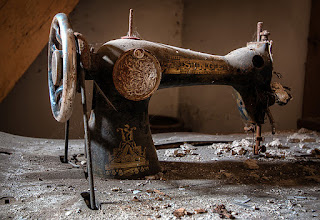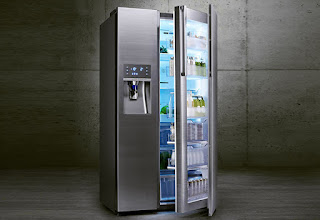21. Photocopier History:
22. Eugene Burton Ely:
24. Sewing Machine History:
25. Electric Light History:
26. Refrigerator History:
A refrigerator consists of a thermally insulated compartment and a heat pump (mechanical, electronic or chemical) that transfers heat from the inside of the fridge to its external environment so that the inside of the fridge is cooled to a temperature below the room temperature. Refrigeration is an essential food storage technique in developed countries. The lower temperature lowers the reproduction rate of bacteria, so the refrigerator reduces the rate of spoilage. Before the invention of the refrigerator, icehouses were used to provide cool storage for most of the year. Placed near freshwater lakes or packed with snow and ice during the winter, they were once very common. More details
27. Telephone History:
28. Elevator History:
An elevator (lift) is a type of vertical transportation machine that moves people or freight between floors, levels, or decks of a building, vessel, or other structure. Elevators are typically powered by electric motors that drive traction cables and counterweight systems such as a hoist, although some pump hydraulic fluid to raise a cylindrical piston like a jack. The earliest known reference to an elevator is in the works of the Roman architect Vitruvius, who reported that Archimedes (c. 287 BC – c. 212 BC) built his first elevator probably in 236 BC. Some sources from later historical periods mention elevators as cabs on a hemp rope powered by hand or by animals. More details
29. Fax Machine History:
Fax (facsimile), sometimes called telecopying or telefax (the latter short for telefacsimile), is the telephonic transmission of scanned printed material (both text and images), normally to a telephone number connected to a printer or other output device. The original document is scanned with a fax machine (or a telecopier), which processes the contents (text or images) as a single fixed graphic image, converting it into a bitmap, and then transmitting it through the telephone system in the form of audio-frequency tones. The receiving fax machine interprets the tones and reconstructs the image, printing a paper copy. Early systems used direct conversions of image darkness to audio tone in a continuous or analog manner. More details
30. MIR Space Station:
31. History of Electromagnetism:
Electromagnetism is a branch of physics involving the study of the electromagnetic force, a type of physical interaction that occurs between electrically charged particles. The electromagnetic force is carried by electromagnetic fields composed of electric fields and magnetic fields, and it is responsible for electromagnetic radiation such as light. It is one of the four fundamental interactions (commonly called forces) in nature, together with the strong interaction, the weak interaction, and gravitation. At high energy the weak force and electromagnetic force are unified as a single electroweak force. More details
32. Central Heating System:
A central heating system provides warmth to the whole interior of a building (or portion of a building) from one point to multiple rooms. When combined with other systems in order to control the building climate, the whole system may be an HVAC (heating, ventilation and air conditioning) system. Central heating differs from space heating in that the heat generation occurs in one place, such as a furnace room or basement in a house or a mechanical room in a large building (though not necessarily at the geometrically "central" point). The heat is distributed throughout the building, typically by forced-air through ductwork, by water circulating through pipes, or by steam fed through pipes. More details
33. Transistor History:
A transistor is a semiconductor device with at least three terminals for connection to an electric circuit. The vacuum-tube triode, also called a (thermionic) valve, was the transistor's precursor, introduced in 1907. The principle of a field-effect transistor was proposed by Julius Edgar Lilienfeld in 1925. John Bardeen, Walter Brattain and William Shockley invented the first working transistors at Bell Labs, the point-contact transistor in 1947 and the bipolar junction transistor in 1948. The MOSFET (metal-oxide-semiconductor field-effect transistor), also known as the MOS transistor, was later invented by Mohamed Atalla and Dawon Kahng at Bell Labs in 1959. More details
34. Phonograph History:
A phonograph, in its later forms also called a gramophone (as a trademark since 1887, as a generic name in the UK since 1910) or since the 1940s called a record player, is a device for the mechanical recording and reproduction of sound. The sound vibration waveforms are recorded as corresponding physical deviations of a spiral groove engraved, etched, incised, or impressed into the surface of a rotating cylinder or disc, called a "record". To recreate the sound, the surface is similarly rotated while a playback stylus traces the groove and is therefore vibrated by it, very faintly reproducing the recorded sound. More details
35. Telegraph History:
An electrical telegraph was a point-to-point text messaging system, used from the 1840s until better systems became widespread. It used coded pulses of electric current through dedicated wires to transmit information over long distances. It was the first electrical telecommunications system, the most widely used of a number of early messaging systems called telegraphs, devised to send text messages more rapidly than written messages could be sent. This system allowed for communication to occur without the necessity of physical transportation. Prior to this, beacons, smoke signal, flag semaphore, and optical telegraphs used visual signals to communicate over distances of land. More details
36. Wireless Telegraphy:
Wireless telegraphy or radiotelegraphy is transmission of telegraph signals by radio waves; Before about 1910 when radio became dominant, the term wireless telegraphy was also used for various other experimental technologies for transmitting telegraph signals without wires, such as electromagnetic induction, and ground conduction telegraph systems. Radiotelegraphy was the first means of radio communication; the first practical radio transmitters and receivers invented in 1894–1895 by Guglielmo Marconi used radiotelegraphy. It continued to be the only type of radio transmission during the first three decades of radio, called the "wireless telegraphy era" up until World War I. More details
37. Telex History:
The telex network was a customer-to-customer switched network of teleprinters similar to a telephone network, using telegraph-grade connecting circuits for two-way text-based messages. Telex was a major method of sending written messages electronically between businesses in the post-World War II period. Its usage went into decline as the fax machine grew in popularity in the 1980s. The "telex" term refers to the network, not the teleprinters; point-to-point teleprinter systems had been in use long before telex exchanges were built in the 1930s. Teleprinters evolved from telegraph systems, and, like the telegraph, they used binary signals, with symbols represented by the presence or absence of a certain level of electric current. More details
38. Catapult History:
A catapult is a ballistic device used to launch a projectile a great distance without the aid of explosive devices—particularly various types of ancient and medieval siege engines. In use since ancient times, the catapult has proven to be one of the most effective mechanisms during warfare. In modern times the term can apply to devices ranging from a simple hand-held implement to a mechanism for launching aircraft from a ship. The last large scale military use of catapults was during the trench warfare of World War I. During the early stages of the war, catapults were used to throw hand grenades across no man's land into enemy trenches. More details
39. Satellite History:
The first artificial satellite was Sputnik 1, launched by the Soviet Union on 4 October 1957 under the Sputnik program, with Sergei Korolev as chief designer. Sputnik 1 helped to identify the density of high atmospheric layers through measurement of its orbital change and provided data on radio-signal distribution in the ionosphere. The unanticipated announcement of Sputnik 1's success precipitated the Sputnik crisis in the United States and ignited the so-called Space Race within the Cold War. Sputnik 2 was launched on 3 November 1957 and carried the first living passenger into orbit, a dog named Laika. More details
40. Telescope History:
A telescope is an optical instrument using lenses, curved mirrors, or a combination of both to observe distant objects, or various devices used to observe distant objects by their emission, absorption, or reflection of electromagnetic radiation. The first known practical telescopes were refracting telescopes invented in the Netherlands at the beginning of the 17th century, by using glass lenses. They were used for both terrestrial applications and astronomy. The earliest existing record of a telescope was a 1608 patent submitted to the government in the Netherlands by Middelburg spectacle maker Hans Lippershey for a refracting telescope. More details




















